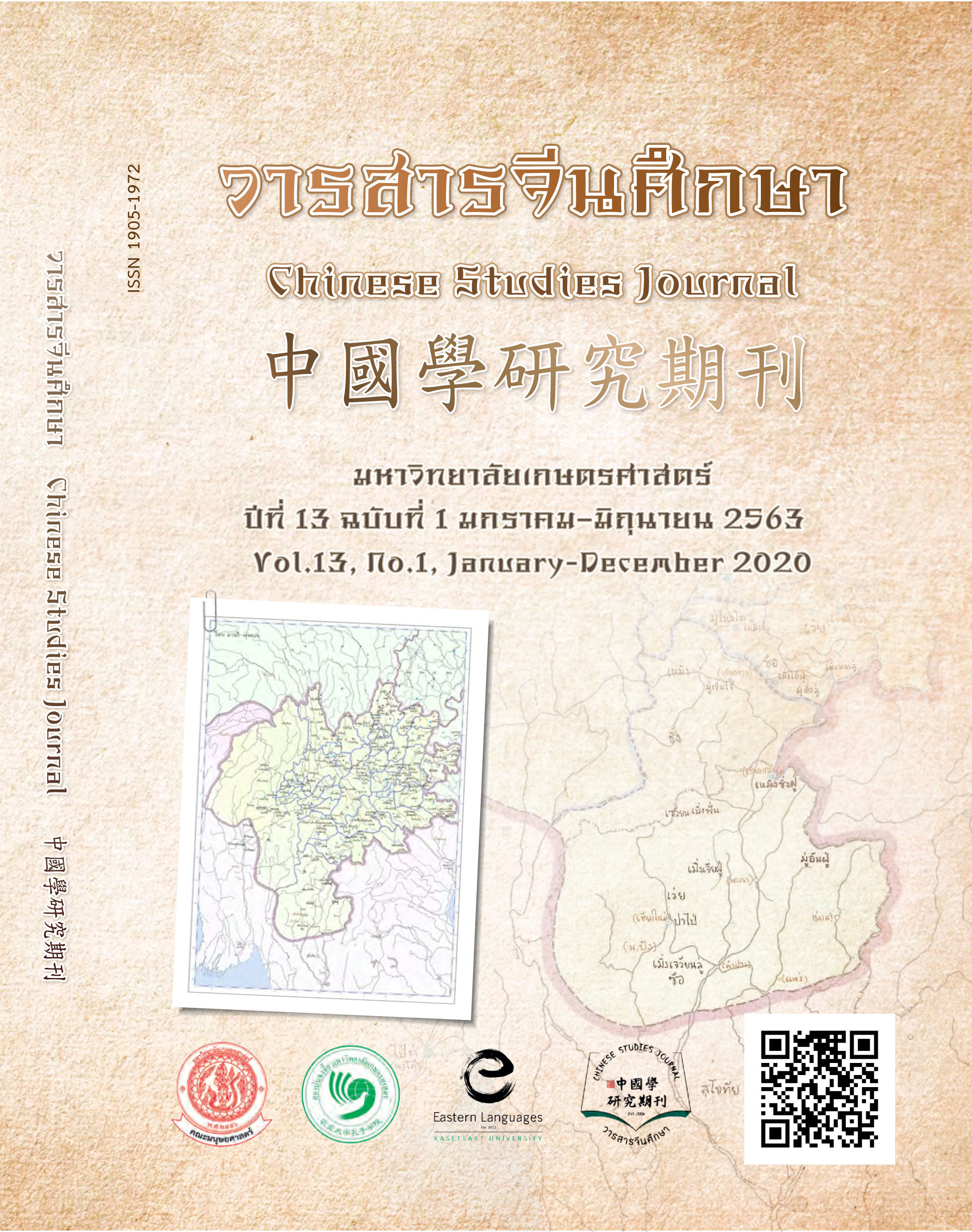Chinese Idioms: The Worldviews of Chineses toward Chinese Women
Main Article Content
Abstract
This qualitative research was conducted to investigate the worldviews towards Chinese women through Chinese idioms. The research aimed to study the reflections of Chinese women through Chinese idioms from the perspectives of sex, gender, and sexuality. The data were 302 idioms collected from Chinese idiom dictionaries. The study of Chinese idioms could reflect the viewpoints of Chinese society in the past towards women. The results indicated that there were three main worldviews towards Chinese women through Chinese idioms: 1) the worldviews towards women in terms of appearances, behaviors, and emotions, 2) the worldviews towards women in terms of ages, namely women as a child, as a grown-up, and as an elderly, and 3) the worldviews towards women in terms of social status, including women as a daughter, as a wife, as a mother, and as equal as men. In the past, Chinese people considered that men and women were different. They also perceived that different physical appearances of men and women determined women’s status and lifestyle. Moreover, to follow different ethics and rules among men and women was considered as a principle of living together in society.
Article Details
ผลงานทางวิชาการที่ลงตีพิมพ์ในวารสารจีนศึกษา มหาวิทยาลัยเกษตรศาสตร์ เป็นลิขสิทธิ์ของผู้เขียนหรือผู้แปลผลงานนั้น หากนำลงในวารสารจีนศึกษาเป็นครั้งแรก เจ้าของผลงานสามารถนำไปตีพิมพ์ซ้ำในวารสารหรือหนังสืออื่นได้โดยมิต้องแจ้งให้ทราบล่วงหน้า แต่หากผลงานที่ได้รับพิจารณานำลงในวารสารจีนศึกษา เป็นผลงานที่เคยตีพิมพ์ที่อื่นมาก่อนเจ้าของผลงานต้องจัดการเรื่องปัญหาลิขสิทธิ์กับแหล่งพิมพ์แรกเอง หากเกิดปัญหาทางกฎหมาย ถือว่าไม่อยู่ในความรับผิดชอบของวารสารจีนศึกษา มหาวิทยาลัยเกษตรศาสตร์ ทั้งนี้ ความคิดเห็นต่างๆ ในบทความเป็นความคิดเห็นส่วนตัวของผู้เขียน ไม่เกี่ยวกับกองบรรณาธิการวารสารจีนศึกษา มหาวิทยาลัยเกษตรศาสตร์
References
เกรียงไกร กองเส็ง. (2559). “ร่างกายภายใต้บงการ”การเปลี่ยนแปลงความหมาย “ความ
งาม” ของสตรีไทย-จีนตามวิถีสมัยใหม่, วารสารมหาวิทยาลัยราชภัฏลำปาง, 5 (2):
235-249.
พจนานุกรม ฉบับราชบัณฑิตสถาน ปี พ.ศ. 2554. สืบค้น 27 ธันวาคม 2562, เข้าถึงได้จาก
http://www.royin.go.th/dictionary/
เรณุกา สิทธิตถะวงศ์. (2559). “การใช้ถ้อยคำเปรียบเทียบ “สุนัข” กับ “คน”ในภาษาไทย
และภาษาจีน, วารสารเทคโนโลยีภาคใต้, 9 (2): 159-167.
วิลาสินี พิพิธกุล และ กิตติ กันภัย. (2546). รายงานวิจัยเรื่องเพศและการสื่อสารใน
สังคมไทย. กรุงเทพฯ: จุฬาลงกรณ์มหาวิทยาลัย.
เสาวภาคย์ วรลัคนากุล. (2547). ตำราสุภาษิตจีน. กรุงเทพฯ: มหาวิทยาลัยรามคำแหง.
อดุลย์ รัตนมั่นเกษม. (2548). เรื่องเพศในวัฒนธรรมจีน 4,000 ปี. กรุงเทพฯ: สุขภาพใจ.
ภาษาต่างประเทศ
成语大词典编委会. (2017). 成语大词典(最新修订版). 北京:
商务印书馆.
高 岩. (2016). 成语的起源与来源.佳木斯职业学院. 第6期.
耿静静. (2005). 谚语中的中国古代女性文化透视. 河北大学硕士论文.
顾 珺. (2016). 汉语熟语的性别歧视. 华侨大学硕士论文.
郭 丽. (2009). 唐代“以胖为美”之女性审美观演变考论. 乐山师范学院
学报, 第24卷第10期: 7-10.
黄伯荣、廖序东.(2002). 现代汉语. 北京: 高等教育出版社.
汉 典. สืบค้น 27 ธันวาคม 2562, เข้าถึงได้จาก www.zdic.net/
汉语大辞典. สืบค้น 29 ธันวาคม 2562, เข้าถึงได้จาก www.hydcd.com
罗常培. (2015). 语言与文化: 中国人与中国文. 北京: 新星出版社.
徐 剑. (2005). 熟语中所体现的矛盾女性观. 前沿, 第9期.
杨德峰. (1999). 汉语与文化交际.北京: 北京大学出版社.
姚思琦. (2018). 认知视阈下中泰“鸡”隐喻的对比研究,Journal of
International Studies,8(1).
赵蓉晖. (2003). 语言与性别. 上海: 上海外语教育出版社.
中国社会科学院.(2012). 现代汉语词典第6版. 北京: 商务印书馆.
周小俊. (2011). 成语女性文化内涵养分, 教育旬刊.
左洪涛. (2017). 论唐人前后期女性审美习俗演变. 中南民族大学学报(人
文社会科学版), 第37卷第4期:161-165.
ภาพประกอบ
ภาพวาดฝาผนังพระสนมเอกหยางกุ้ยเฟย ที่มาภาพ
http://www.sohu.com/a/303493935_120033480 . [วันที่เข้าถึง 27 ธันวาคม
2562].
ภาพวาดจำลองของพระนางเจ้าเฟยเยี่ยน ที่มาภาพ
https://baike.baidu.com/item/赵飞燕/40226 . [วันที่เข้าถึง 27 ธันวาคม
2562].
ภาพลักษณะอันพึงประสงค์ของสตรี ที่มาภาพ
https://www.youtube.com/watch?v=x3MB-
uzCG0w&list=PLn7ueQx7cc2zLUougY8NMGIdQTFQslL5s&index=2 .
[วันที่เข้าถึง 27 ธันวาคม 2562].


